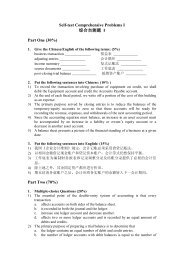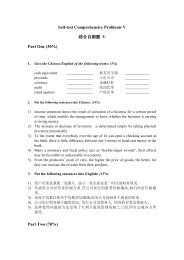Vodafone Group Plc Annual Report for the year ended 31 March 2012
Vodafone Group Plc Annual Report for the year ended 31 March 2012
Vodafone Group Plc Annual Report for the year ended 31 March 2012
You also want an ePaper? Increase the reach of your titles
YUMPU automatically turns print PDFs into web optimized ePapers that Google loves.
<strong>Vodafone</strong> <strong>Group</strong> <strong>Plc</strong><br />
<strong>Annual</strong> <strong>Report</strong> <strong>2012</strong><br />
125<br />
Financial risk management<br />
The <strong>Group</strong>’s treasury function provides a centralised service to <strong>the</strong> <strong>Group</strong> <strong>for</strong> funding, <strong>for</strong>eign exchange, interest rate management and counterparty<br />
risk management.<br />
Treasury operations are conducted within a framework of policies and guidelines authorised and reviewed by <strong>the</strong> Board, most recently on 27 <strong>March</strong><br />
<strong>2012</strong>. A treasury policy committee comprising of <strong>the</strong> <strong>Group</strong>’s Chief Financial Officer, <strong>Group</strong> General Counsel and Company Secretary, <strong>Group</strong><br />
Treasury Director and Director of Financial <strong>Report</strong>ing meets at least annually to review treasury activities and its members receive management<br />
in<strong>for</strong>mation relating to treasury activities on a quarterly basis. The <strong>Group</strong>’s accounting function, which does not report to <strong>the</strong> <strong>Group</strong> Treasury Director,<br />
provides regular update reports of treasury activity to <strong>the</strong> Board. The <strong>Group</strong>’s internal auditor reviews <strong>the</strong> internal control environment regularly.<br />
The <strong>Group</strong> uses a number of derivative instruments <strong>for</strong> currency and interest rate risk management purposes only that are transacted by specialist<br />
treasury personnel. The <strong>Group</strong> mitigates banking sector credit risk by <strong>the</strong> use of collateral support agreements.<br />
Credit risk<br />
The <strong>Group</strong> considers its exposure to credit risk at <strong>31</strong> <strong>March</strong> to be as follows:<br />
<strong>2012</strong> 2011<br />
£m £m<br />
Bank deposits 2,762 896<br />
Repurchase agreements 600 –<br />
Cash held in restricted deposits 333 338<br />
Government bonds 900 610<br />
Money market fund investments 3,190 5,015<br />
Derivative financial instruments 2,959 2,045<br />
O<strong>the</strong>r investments – debt and bonds 160 75<br />
Trade receivables 4,005 4,277<br />
O<strong>the</strong>r receivables 3,219 3,325<br />
O<strong>the</strong>r 586 341<br />
18,714 16,922<br />
The <strong>Group</strong> invests in UK index linked government bonds on <strong>the</strong> basis that <strong>the</strong>y generate a swap return in excess of £ LIBOR and are amongst <strong>the</strong><br />
most creditworthy of investments available.<br />
Money market investments are in accordance with established internal treasury policies which dictate that an investment’s long-term credit rating is<br />
no lower than mid BBB. Additionally, <strong>the</strong> <strong>Group</strong> invests in AAA unsecured money market mutual funds where <strong>the</strong> investment is limited to 7.5% of<br />
each fund.<br />
The <strong>Group</strong> has investments in repurchase agreements which are fully collateralised investments. The collateral is sovereign and supranational debt<br />
of major AAA rated EU countries denominated in euros and US dollars and can be readily converted to cash. In <strong>the</strong> event of any default, ownership of<br />
<strong>the</strong> collateral would revert to <strong>the</strong> <strong>Group</strong>. Detailed below is <strong>the</strong> value of <strong>the</strong> collateral held by <strong>the</strong> <strong>Group</strong> at <strong>31</strong> <strong>March</strong> <strong>2012</strong>.<br />
<strong>2012</strong> 2011<br />
£m £m<br />
Sovereign 575 –<br />
Supranational 25 –<br />
600 –<br />
In respect of financial instruments used by <strong>the</strong> <strong>Group</strong>’s treasury function, <strong>the</strong> aggregate credit risk <strong>the</strong> <strong>Group</strong> may have with one counterparty is<br />
limited by (i) reference to <strong>the</strong> long-term credit ratings assigned <strong>for</strong> that counterparty by Moody’s, Fitch Ratings and Standard & Poor’s, (ii) that<br />
counterparty’s five <strong>year</strong> credit default swap (‘CDS’) spread, and (iii) <strong>the</strong> sovereign credit rating of that counterparty’s principal operating jurisdiction.<br />
Fur<strong>the</strong>rmore, collateral support agreements were introduced from <strong>the</strong> fourth quarter of 2008. Under collateral support agreements <strong>the</strong> <strong>Group</strong>’s<br />
exposure to a counterparty with whom a collateral support agreement is in place is reduced to <strong>the</strong> extent that <strong>the</strong> counterparty must post cash<br />
collateral when <strong>the</strong>re is value due to <strong>the</strong> <strong>Group</strong> under outstanding derivative contracts that exceeds a contractually agreed threshold amount.<br />
When value is due to <strong>the</strong> counterparty <strong>the</strong> <strong>Group</strong> is required to post collateral on identical terms. Such cash collateral is adjusted daily as necessary.<br />
In <strong>the</strong> event of any default ownership of <strong>the</strong> cash collateral would revert to <strong>the</strong> respective holder at that point. Detailed below is <strong>the</strong> value of <strong>the</strong> cash<br />
collateral, which is reported within short-term borrowings, held by <strong>the</strong> <strong>Group</strong> at <strong>31</strong> <strong>March</strong> <strong>2012</strong>:<br />
<strong>2012</strong> 2011<br />
£m £m<br />
Cash collateral 980 5<strong>31</strong><br />
The majority of <strong>the</strong> <strong>Group</strong>’s trade receivables are due <strong>for</strong> maturity within 90 days and largely comprise amounts receivable from consumers and<br />
business customers. At <strong>31</strong> <strong>March</strong> <strong>2012</strong> £1,806 million (2011: £2,233 million) of trade receivables were not yet due <strong>for</strong> payment. Total trade<br />
receivables consisted of £2,672 million (2011: £2,852 million) relating to <strong>the</strong> Europe region and £1,333 million (2011: £1,425 million) relating to <strong>the</strong><br />
Africa, Middle East and Asia Pacific region. Accounts are monitored by management and provisions <strong>for</strong> bad and doubtful debts raised where it is<br />
deemed appropriate.<br />
Business review Per<strong>for</strong>mance Governance Financials Additional in<strong>for</strong>mation






